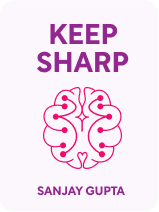

This article is an excerpt from the Shortform book guide to "Keep Sharp" by Sanjay Gupta. Shortform has the world's best summaries and analyses of books you should be reading.
Like this article? Sign up for a free trial here .
What is Sanjay Gupta’s Keep Sharp about? What is the key to keeping your brain sharp as you age?
In Keep Sharp, Sanjay Gupta provides advice for improving your brain health. It’s not just about improving intelligence or memory: It’s about developing a brain that is resilient and creating a brain that can build new cells and use the cells you have more efficiently. If you have a healthy, resilient brain, you’ll be happier, more productive, and better equipped to fight off cognitive decline as you age.
Below is a brief overview of Keep Sharp by Sanjay Gupta.
Keep Sharp: Build a Better Brain at Any Age
As a neurosurgeon and medical reporter, Sanjay Gupta has extensive knowledge of the human brain and how it functions. For Keep Sharp, Sanjay Gupta interviewed some of the leading experts on neuroscience and reviewed the latest research. Gupta explores five key components of brain health: exercise, sleep, nutrition, discovery, and connection. While these may seem like obvious components of a healthy lifestyle, we’ll show how important they are for a healthy brain specifically.
How the Brain Works
Gupta argues that to better understand how to improve your brain, you must first understand how it works. With regard to improving brain health, there are two key attributes of the brain you should understand: interconnectedness and neuroplasticity.
Interconnectedness
Gupta claims that our growing understanding of the brain has taught us that different parts of the brain function in a highly coordinated manner. Because of this, we should focus on improving the functions of every part of the brain, not just the areas we may deem most important. Not too long ago, it was thought that the brain was split up into separate parts that acted on their own: One part of the brain was used for abstract thinking, another for interpreting language. This led to the debunked theory that people are either left- or right-brain dominant. We now know, however, that much of the brain’s power and complexity comes not from the individual sections, but from the communication between each section.
Communication within the brain happens between neurons through synaptic connections, writes Gupta. There are billions of neurons, or brain cells, in the human brain, and trillions of synapses through which information is transmitted from one neuron to another via electrical signals. It is through these neural connections that our brains can perform both simple and complex tasks. These connections allow us to make decisions, communicate, analyze information, feel emotions, orient ourselves, coordinate movements, and so forth. In other words, our brains are highly dependent on the circuitry between different areas. Maintaining and strengthening this circuitry is crucial to a healthy brain.
Neuroplasticity
Gupta adds that neuroplasticity is another important concept to understand about the brain. Neuroplasticity is the brain’s ability to grow and reorganize its neural networks through learning, experience, or response to injury. According to Gupta, the plasticity of our brains may allow us to fight off cognitive decline. When you experience something new, your brain reshapes itself to integrate this new information. It does this by creating new dendrites. Dendrites are the parts of a neuron (brain cell) that receive electrical signals from another neuron. The brain’s ability to create new dendrites is what is known as plasticity. Importantly, this ability remains with us throughout our lives. No matter how old you are, you can take steps to strengthen and preserve your brain.
The brain is constantly shaping and reorganizing itself in response to the stimuli it receives, says Gupta. Because of this, what you choose to focus on shapes the brain’s circuitry. For example, if you learn a song on the guitar, you form new connections between your neurons. If you keep practicing, these connections will strengthen until eventually you can play the song easily from memory. If you stop practicing, these connections will weaken rather quickly while new ones form or others strengthen. This information is key because it suggests that we may be able to slow down, reverse, or even stop degenerative brain diseases by strengthening our neural connections.
Potential Factors Leading to Cognitive Decline
Gupta claims that maintaining the quality and quantity of our neural connections can help prevent cognitive decline, but the exact causes of dementia are still unknown. Medical scientists and researchers have discovered a lot about cognitive decline, dementia, and Alzheimer’s in the last few decades, and their research suggests it’s probably due to many factors that differ for every person. If we want to take care of our brains and take measures to prevent them from declining, it will be helpful to know the suspected factors that lead to cognitive decline.
Amyloid Plaque Buildup
According to Gupta, an abundance of amyloid plaque in a person’s brain is a hallmark of Alzheimer’s disease. Amyloid is a protein that helps supply food to brain cells. For unknown reasons, these proteins sometimes become damaged and fold up into a sticky plaque that accumulates outside neurons. When plaques form, they prevent synapses from effectively communicating. If enough synapses are inhibited by amyloid plaques, the brain may lose many of its functions.
Though amyloid plaque has long been connected to cognitive decline, it is still unknown if it is a cause, an effect, or both. Some autopsied brains have been filled with amyloid plaques, yet the patient never showed major signs of cognitive impairment. Also, dementia patients rarely show damage exclusively from amyloid plaques. There are many other ways a brain can be damaged that can lead to dementia.
Blood Flow
Gupta claims that blood flow abnormalities in the brain may also be an important factor in the development of Alzheimer’s disease. For one, amyloid plaques are seen more frequently in people with vascular diseases (diseases that affect the blood vessels). The brain requires a lot of nutrients and oxygen from our blood. Because of this, problems with the vascular system often lead to a dysfunctional brain.
Because the brain is so important, it is protected by a barrier between the brain and the blood supply. This blood-brain barrier lets oxygen, glucose, and other nutrients in while keeping toxic substances out. Due to aging, infections, or vascular damage, gaps sometimes form in this blood barrier. When this happens, toxic substances from the blood can damage neurons and impair memory and other brain functions.
Metabolic Disorders
Metabolic disorders include diabetes, obesity, and high blood pressure. They are extremely common in the West, and Gupta argues that these disorders are heavily associated with risk for dementia. Alzheimer’s disease often involves a problem with insulin, the hormone responsible for delivering glucose from the bloodstream to the cells.
Without insulin, the cells don’t get the glucose they need to produce energy, explains Gupta. In Type 2 diabetes, there is so much sugar in the blood, and so much insulin is pumped out by the pancreas in response, that the cells become desensitized to insulin. Some believe this insulin resistance plays a key role in cognitive decline, with studies suggesting those with Type 2 diabetes may be twice as likely to develop Alzheimer’s disease. In fact, Alzheimer’s is sometimes referred to as Type 3 diabetes. Not only this but high blood sugar, even without meeting diabetic conditions, has also been linked to cognitive decline. The higher your blood sugar, the more likely you are to develop dementia.
Inflammation
Gupta suggests that chronic inflammation is also at the center of neurodegenerative diseases such as Alzheimer’s. Inflammation is the body’s defense against infections, injuries, and toxins. It is meant to protect our bodies, but when it becomes chronic, it can be damaging.
Research indicates that chronic inflammation both adds to and kick-starts the process of cognitive decline. For instance, some studies have linked dementia to higher levels of cytokines, which are released by cells during bouts of inflammation. Also, chronic inflammation in middle-aged adults has been linked to dementia later in life. Both of these findings suggest that chronic inflammation likely plays an important role in cognitive decline.
The 5 Ingredients of a Healthy Brain
Gupta claims that maintaining a healthy brain is a key to overall health and that prevention is the most effective antidote to neurodegenerative diseases and cognitive decline. We rarely think about Alzheimer’s or cognitive impairment until later in life. According to Gupta, this is a mistake because brain-related illnesses can start decades before symptoms appear. A decline in cognitive abilities begins in your 20s, and the brain’s structure can start to decay at age 30. However, if you can focus on living a healthy lifestyle from a young age, with a particular focus on your brain, you will be much more likely to avoid cognitive decline. At the very least, you will be able to delay it.
Gupta gives five areas to focus on when trying to improve your brain’s health: exercise, sleep, nutrition, discovery, and social connection. We’ll examine each of these in turn.
Exercise
Gupta claims that regular exercise is the single most important thing to do for your brain’s health. While there are many other benefits to brain and body, exercise helps the brain in two main ways:
1. Exercise controls blood sugar: When you exercise, the sugar in your blood is used to fuel the muscles in your body instead of staying in your bloodstream. This prevents consistently high blood sugar and keeps your insulin levels stable.
2. Exercise reduces stress: When you’re stressed, your body releases a hormone called cortisol, which has been linked to changes in the brain. People who experience chronic stress early in life are much more likely to suffer from mental problems and mood disorders later in life.
Physical inactivity, on the other hand, sharply increases the risk of cognitive decline. Gupta points to a study that states that lack of exercise is the most significant risk factor in developing dementia. Prolonged sitting (sitting for eight or more hours a day) can be especially harmful. Not only does prolonged sitting increase blood sugar levels, but it also negatively affects blood fats, cholesterol, blood pressure, and leptin (the hormone that tells you when to stop eating). When your muscles are dormant for too long, they begin to break down and atrophy, and your body’s ability to break down calories is weakened.
Exercise Tips
Knowing how important exercise is, how much do we need to do? Gupta says the good news is that it doesn’t take a lot to counteract the negative effects of inactivity. Aim for at least 30 minutes of exercise a day, five times a week. However, Gupta claims that if you want to get the most out of exercise, exercising more than an hour a day is now recommended. This is because, from an evolutionary perspective, humans have usually spent most of their day moving.
To get the most out of exercise, also aim for a mix of three forms of exercise: aerobic, strength, and interval training.
- Aerobic exercise: Aerobic exercise, also known as cardio (like jogging, swimming, biking, or even brisk walking) involves getting your heart rate and breathing up.
- Strength training: Strength training involves using weights or your own body weight to gain muscle mass. It’s important because muscles are crucial in burning calories and maintaining overall metabolic health.
- Interval training: Interval training involves alternating between various levels of speed and intensity in your workouts. This helps challenge the muscles and prevent them from plateauing.
Sleep
Gupta claims that chronic inadequate sleep leads to higher risk of many health issues including dementia and cognitive decline. Extensive research on the effects of sleep shows that sleep is more than just the body’s chance to relax: It’s a vital phase of neural activity and regeneration. In this section, we’ll first look at what happens in our brains when we sleep. Once we understand this, we’ll go over some of Gupta’s tips for consistently getting a better night’s rest.
Our Brains During Sleep
Gupta claims that our brains perform billions of molecular tasks while we sleep. Because of this, sleep keeps us sharp, creative, and able to process information. Sleep keeps our brains healthy in three key ways, says Gupta:
1. Sleep controls our hormonal cycles: Our circadian rhythms revolve around our sleeping habits, and these rhythms dictate our hormonal patterns. These hormonal patterns help regulate our appetites, stress levels, and cellular recovery. People who don’t get enough sleep on a regular basis are likely to have issues with their metabolism and stress levels—and thus, their brain’s function.
2. Sleep helps us encode memories and process information: A recent theory suggests that our brains consolidate our memories during sleep. Essentially, while we sleep, our brains move information from our short-term to our long-term memory. Furthermore, when we don’t sleep enough, our brains lose the ability to process information at all. In other words, not only do we struggle to remember things later on, but we also struggle to even take in the information in the first place.
3. Sleep helps our brain’s cleansing process: Recent studies show that our brains remove excess waste through something called the glymphatic system. When we sleep, this system greatly increases its output. Sleep helps get rid of the waste from our metabolic system, which includes the amyloid plaques that have been linked to dementia.
Problems Associated With Sleep Deprivation
Gupta goes over several studies that exhibit the different effects sleep deprivation has on the body. They are all related to each other, and they all can lead to brain impairment.
- A study showed that people who sleep less than six hours a night after a major coronary event were 29% more likely to suffer a second one.
- Another study revealed that sleeping less than six hours a night increases the chance of prediabetes developing into diabetes by 44%. Less than five hours of sleep and this number goes up to 68%.
(Shortforn note: Why does this happen? Sleep can affect blood sugar for several reasons. Even one night of sleep deprivation can lead to increased insulin resistance, the main factor behind Type 2 diabetes.)
- One study found that just one night of inadequate sleep is enough to activate the inflammation process in the body. For unknown reasons, this is especially true for women.
Tips for Better Sleep
Gupta provides some easy-to-follow advice on getting more consistent rest:
Stay on schedule: Irregular sleep patterns are harmful to your health. Try to get up and go to sleep at roughly the same time every day. It can also help to establish bedtime rituals in which you take time to unwind and do something you find relaxing.
Pay attention to diet: What you eat and drink can affect your sleep. Caffeine after 2 p.m. can make it harder to fall asleep. Too much water before bed can cause you to wake up in the night to use the bathroom. Late meals and alcohol use can also disturb normal sleep cycles.
Keep your room dark at bedtime: Most forms of light, including sunlight and artificial light from lightbulbs or electronic devices, contain blue wavelengths. These wavelengths suppress melatonin, the hormone that makes you sleepy, and stimulate other areas of the brain that keep you alert.
Nutrition
Gupta claims a healthy diet is a vital part of brain health. As we’ve discussed, metabolic disorders are thought to be a leading factor in cognitive decline. While there is no general consensus on the perfect diet for brain health, there is plenty of evidence to suggest that you should eat certain foods regularly and avoid other foods as much as possible. In this section, we’ll look at why certain foods are good for your brain and why others can be potentially harmful.
Foods to Eat
Most of the foods that are good for your brain should not come as a surprise. Gupta claims that, although it’s difficult to know exactly how foods interact in our bodies, recent studies point to certain diets as being particularly healthy. For example, a Mediterranean diet is extremely beneficial to brain health. This diet consists largely of olive oil, nuts, fish, and a wide variety of fruits and vegetables.
Of these foods, Gupta mentions that berries and leafy green vegetables are especially good for the brain. One reason for this is that they are high in fiber. Fiber is beneficial because it changes the way your body metabolizes food. If you don’t have enough fiber in your diet, the carbs you consume will be absorbed more quickly, which increases your blood sugar and insulin levels, contributing to cognitive decline. Gupta also points out the benefits of omega-3 fatty acids, which are found in fish, nuts, seeds, and plant-based oils like olive oil. Omega-3 fatty acids are crucial in the maintenance of neurons.
Foods to Avoid
In a typical Western diet, there are three ingredients we consume too much: sugar, salt, and saturated fats. We’ll go through each one and discuss why Gupta feels they are bad for the brain.
Sugar: The average American consumes 163 grams of sugar per day. Most of this usually comes in liquid form or from processed foods. Earlier in the guide, we discussed why high levels of sugar in the blood can be bad for the brain: They can make us insulin resistant, leading to diabetes. They can also lead to high levels of inflammation, which can lead to cognitive decline.
Salt: Although Gupta doesn’t go into much detail about why salt is bad for you, he does recommend limiting your intake of it as it has been linked to higher levels of heart disease, stroke, and dementia.
Saturated Fats: Saturated fats are in foods that are typically solid at room temperature, like cheese, butter, and full-fat yogurt. They can also be found in fatty red meats and milk. Saturated fats raise cholesterol and blood pressure levels and, like salt, have been linked to higher levels of chronic diseases.
Learning and Discovery
Gupta argues that keeping your brain active is a vital part of maintaining its health. Learning or discovering new things stimulates the brain, and this stimulation builds a brain more resistant to disease by creating new neural connections (and strengthening existing ones). With stronger neural connections, you are less susceptible to cognitive disruption. With a greater quantity of neural connections, you can offset the disruption through the use of the other networks. This may be how some people whose brains show all the physical signs of Alzheimer’s don’t manifest any symptoms of the disease.
Ways to Stimulate the Brain
Gupta says that the best way to stimulate the brain is through challenging and novel activities. Doing this will increase the brain’s ability to adapt to damage or other challenges (or what scientists call your “cognitive reserve”). When many people think of brain stimulation, they think of brain games or puzzles. While these are helpful for working memory, they aren’t as beneficial for things like problem-solving or reasoning, which are also a big part of cognitive reserve. For this reason, you are much better off taking a class on something you enjoy, learning a language, or doing some other complex skill that gets you out of your comfort zone.
Social Connection
Gupta claims that social interaction is crucial to our psychological well-being and thus our brain health. There is lots of evidence to support this, as strong social connections are a better predictor of long, happy lives than social class, intelligence, or genetics. Lack of social connection has been linked to disrupted sleep patterns, higher levels of inflammation, and higher levels of stress, all of which contribute to cognitive decline.
From an evolutionary perspective, the importance of social connection makes sense. Humans are a very social species. Throughout history, we’ve survived through communal living and reliance on others for food, water, shelter, and protection. In the modern world, as Gupta points out, social isolation is on the rise. Despite being connected to many people through digital media, many people lack real, close connections. If we wish to counteract this and preserve brain health, we must focus on building community with others and establishing meaningful relationships.
Tips for Social Engagement
Gupta provides some ideas for building and maintaining social connections:
First, focus on things you enjoy: Try to spend time with people you enjoy being around and doing the activities you like the most.
Second, volunteer: Giving back to the community can help you form and strengthen social connections. You can do this through a local school, community center, or charity.
Third, build and maintain at least one strong relationship: Having one person in your life you can truly count on is extremely important. If possible, try to communicate with them routinely. Gupta recommends going on a walk with a close friend and talking about your anxieties.

———End of Preview———
Like what you just read? Read the rest of the world's best book summary and analysis of Sanjay Gupta's "Keep Sharp" at Shortform .
Here's what you'll find in our full Keep Sharp summary :
- The steps you can take to prevent cognitive decline such as Alzheimer’s
- How to keep your brain strong and resilient throughout your life
- Foods to eat and avoid to maintain brain health






